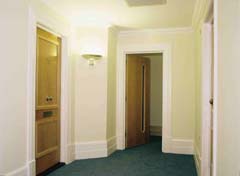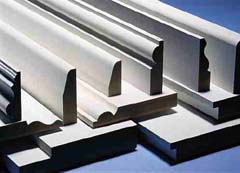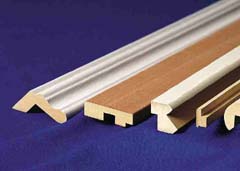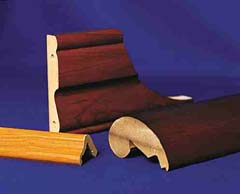Building Applications
4. Architraves, cornices, pelmets and skirtings


Profiled mouldings in MDF, ranging from simple bullnosing to more complicated shapes, are used for a wide range of interior joinery applications. The profiles can be painted, finished with stain and clear lacquer or wrapped with wood veneer or decorative foil.
Wood veneer and foil wrapped MDF mouldings have been used for many years as cornices linking the tops of kitchen wall units and fitted wardrobes. They are now being used more generally for creating a decorative effect along the top edges of storage units in offices, educational establishments and shops. The high stability of MDF ensures better performance when compared to solid timber in extreme conditions found in some buildings.
For the best results, cornices should be fixed at 500 mm centres by concealed screw fixing through the backs of the MDF sections into the tops of the units. Corner joints should be adhesive bonded or secured with concealed corner brackets.
Similarly, wrapped MDF mouldings can he used as pelmets for concealed light fittings creating special interior design effects. Excessive surface temperatures, can he avoided by ensuring adequate ventilation.
MDF mouldings are being used increasingly as skirtings, dados and picture rails round rooms for decorative effect or to protect the walls from damage. In their simplest form, the MDF mouldings can be supplied unfinished or pre-primed for fixing by nailing as an alternative to conventional solid wood mouldings. The recessed nail heads can be filled and the rails painted on site in the normal way.
Pre-finished or wrapped mouldings can be fixed using wall mounted brackets which locate in grooves cut in the backs of the mouldings or by using a special fixing system with an insert strip to cover the nail or screw heads.
The decorative strips fixed round door frames to mask the joints to the surrounding walls are often cut from MDF strips which may be square cut or moulded. The availability of MDF mouldings in long lengths reduces wastage when cutting to length on site. The mitre corner joints between MDF mouldings will remain close fitting despite inevitable changes in ambient conditions.
Specialist companies are now established in most countries for the supply of unfinished, primed and fully finished, moisture resistant MDF mouldings to builders and interior joinery specialists. Other companies specialise in the manufacture and supply of wood veneer or foil wrapped mouldings. Standard grade MDF mouldings are suitable for these applications but increasingly, moisture resistant MDF mouldings are used to eliminate possible problems where the fixing is carried out in damp conditions in a new building or onto walls which have not fully dried out.















